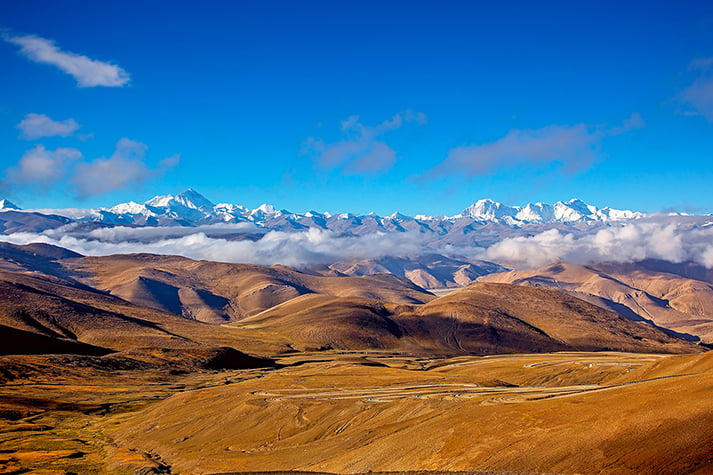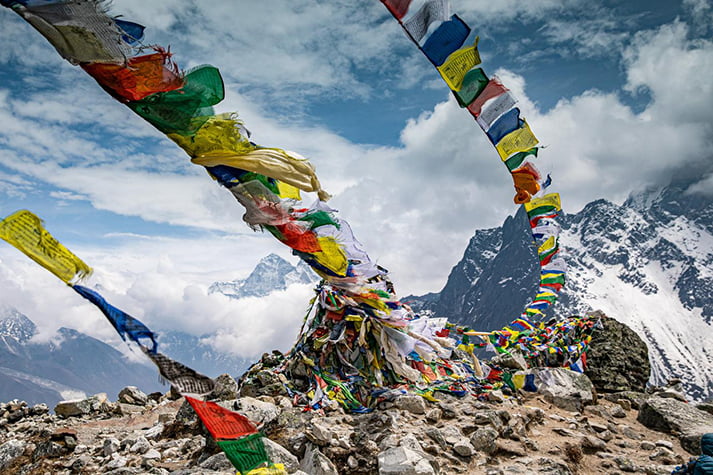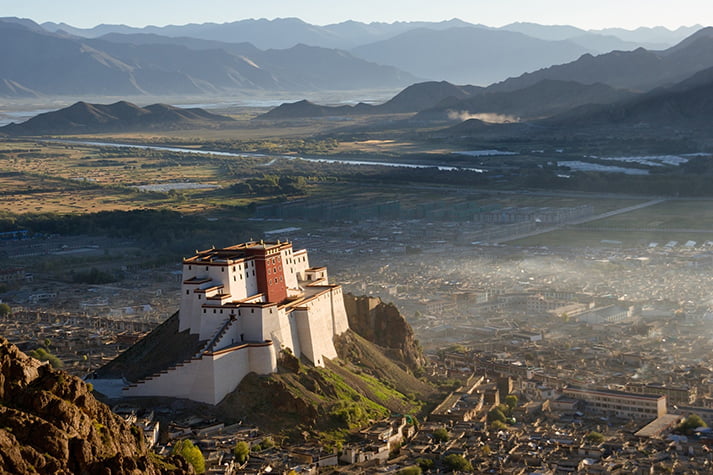I’m a Buddhist practitioner. Which is to presume a circumstantial achievement.
I’m not a Buddhist because that presupposes having achieved a goal that I still pursue.
You are not a Buddhist because you reach a certain state of mind, but because you incorporate it into your daily life. You must practice it daily and it requires attention. It is very easy to fail. You can pretend to be a Buddhist and then have a wrong reaction that shows you otherwise. That is embarrassing, but you must think about it and try again.
Be a Buddhist means being consistent with that reckless claim.
I follow the Tibetan Buddhist philosophy. Not from a religious perspective but like that; as a philosophy of life. This spiritual tradition evidently originates from Tibet. And that amazing place has been going through terrible times for several years. I wrote the text below because I am continually asked about Buddhism, the Dalai Lama and Tibet. I wrote it to spread this serious situation.
I hope you open your mind, heart and find a few minutes to read it.
Everything written on this website is neurotic paraphernalia of my ego. It have no great value.
The real words of value, comes below:

A falta de petróleo no hubo amigos en el mar
dejando las naciones tu barquito naufragar…
-José María Cano / Mecano
From “Dalai Lama” song.
For hundreds of years Tibet was a free country. For the last 70 years, it is not.
Tibet, located at the foot of the Himalayas, is a millenary, legendary and mythical territory surrounded by eternal snows. In 1949 it was a simple and discreet nation, with a modest economic system, rudimentary industry, and a very elementary political system. An imperceptible country, almost inaccessible and whose limited contact with others, gave it a certain inexperience and even political innocence as a nation. In essence, the main activity of its citizens was to lead a traditional subsistence, in a very difficult environment, above all inspired by a strong spiritual and contemplative conviction. Its existence was oriented to an ancestral Buddhist practice shared with the monks who lived in any of the thousands of temples across the country. Thus, for most Tibetan citizens, meditation was a daily practice that they had a deep need for.
But one day in 1949, suddenly; China invaded the territory of Tibet.
With deception, manipulation and lies; the Chinese government justified the invasion with the false argument that in the past, this territory belong to them. Furthermore, it was necessary to intervene it in order to free the people from their religious tradition and from the leaders who led it. Consequently, China took Tibet and split it in two. The eastern region was divided between four Chinese provinces and the west was converted into a so-called «autonomous» region. Although in reality, never enjoyed any autonomy.

The Chinese invasion was initially an aggressive displacement of troops. Tibet did not even have an army, it only had a small symbolic guard at the service of Tenzin Gyatso the 14th and current Dalai Lama (who was only 13 years old). And therefore, it was the population -and even many monks- who protested to defend their nation. Of course, they had no weapons, but instead they have a deep conviction that patience, correct course, and peaceful resistance would pay off. However, the invading army would gradually increase its number and aggressiveness until reach an intolerable point where the armed force had a habitual violent and ruthless behavior against people and monks.
Thus, after the first years of the invasion, the Chinese Government troops mercilessly crushed the population, religion, culture and territory. Tibet, like any free country; it had its own language, religion, flag, currency, sovereignty, law, and government. And -despite being a society of a pacifist nature- continuous abuses, destruction, offenses, impunity and crimes against the inhabitants; exhausted the patience of many and led them into a desperate revolt in search of freedom.
Thus, ten years after the invasion, on March 10, 1959; an uprising occurred where most of those raised were brutally massacred and the survivors arrested and tortured. The Chinese response was immediate and bloody and in revenge, the rest of the population was violently repressed. That year, 87,000 Tibetan citizens -monks, men, women and children; whose existence was peaceful, noble and spiritual-; would be brutally and cowardly murdered.

Of course, the capture of the Dalai Lama become a strategic objective for China since -at that time- Tenzin Gyatso besides a monk was simultaneously the spiritual leader of the Tibetan people and also their political leader. Fortunately, the Dalai Lama was warned of his impending arrest and made a surprising escape for his life. Disguised as a Tibetan guard, he left the Norbulingka Palace and embarked on a dangerous 1500-kilometer trek from Lhasa, through the inhospitable Himalayas, in direction of Dharamsala; a small town in northern India. In the following months, he was followed by more than 120,000 Tibetans who made the same route under extreme conditions.
Since then, as a consequence of the atrocious acts of occupation; more than 1 million Tibetans would die. A sixth of its population was victim of a genocide that continues with impunity. And in the same way, since then, a systematic abuse of elementary human rights has developed. Until today, arbitrary detentions, unjustified arrests, torture, incommunicado detention, mock trials, absurd convictions, forced disappearances, and executions are common practice. In clear sight from the international community -which although it rejects what happened- has rarely expressed its open opposition.

Since then -to keep these atrocities away from global media- China restricted any access to Tibet for the international press and simultaneously prohibited any contact between Tibetans and foreigners. This complicated the possibility of evidencing the crimes. Freedom of expression disappeared. Harmless acts as the phrase Freedom for Tibet, possessing the Tibetan Nationalist Flag or even an image of the Dalai Lama; put Tibetans at risk of arrest, torture, accusation, death or transfer to labor camps -such as Drapchi- where death and disappearance of prisoners was a daily occurrence for decades.
And despite the fact that, in 1960, the International Commission of Jurists wrote a report in which it concluded that Tibet was a historically independent state; and that -between 1961 and 1965- the United Nations Organization passed two resolutions in favor of the self-determination of Tibet; China not only remained in the territory, but increased its fury and employed brutal new tactics of domination.
Thus, since 1980 an aggressive program of ethnic cleansing, conversion and cultural re-education was implemented by China that included looting and systematic destruction of the Tibetan religious and cultural heritage, transfers of large sectors of the population from China to Tibet, restriction of the transit of Tibetan citizens, control of access and contact with foreigners, child indoctrination, mass sterilization and forced abortions.

Then, the Chinese population that was transferred surpassed the original Tibetan population by an order of 3 to 2. Today 80% of Tibetans are illiterate and are in extreme poverty conditions, since serious internal policies were established that they prevented access to educational or hospital services. In all procedures, or requests for basic services, jobs, acquisition of homes or rent of commercial lands; the Chinese have priority. The only way for a Tibetan to obtain formal education or job is by publicly renouncing their Tibetan identity and accepting the use of the Chinese language as the only and mandatory. The same situation occurs in employment and health services as they must renounce their mother tongue, culture, religion and thus swear allegiance to the Chinese Government. They are even forced to put a Chinese flag on the door of their homes.
The Buddhist religious tradition was one of the initial targets and consequently China banned its practice. Thus 95% of the 6250 existing monasteries in 1949 were looted and destroyed. The cultural heritage that these contained in the form of crafts or religious instruments was stolen and sent to China. Thousands of precious metals were stolen and sent to the foundry. Its monks -in the best of cases- were expelled, although those who resisted were imprisoned or brutally murdered.

Since 1959 the Dalai Lama established the Tibetan Government in Exile (GTE) and made Dharamsala it residence. And since then, he initiate constant contacts with the outside, seeking to give a voice to the Tibetan people, in the most important forums worldwide, to demonstrate their serious situation, to spread the spiritual and cultural Tibetan Buddhist legacy; but, above all; to seek principles of conciliation and negotiation with China.
For 30 years, the Dalai Lama maintained a noble policy of peaceful resistance that gave him global respect and admiration. So much, so soon he was nominated and awarded the Nobel Peace Prize in 1989. Similarly, on October 17, 2007, the United States Congress awarded him the Congress Gold Medal, the highest distinction given in North America to a civilian. An important recognition of his tireless nonviolent struggle, his exemplary practice of Buddhist values and his impeccable career. Even twice, in 2010 and 2014, he was received at the White House by President Barack Obama. Ironically, despite global recognition, the Chinese government continued to fail to recognize him as a legitimate interlocutor for the Tibetan people.
At this point, in the absence of viable solutions and China’s refusal to reach agreements, and in the face of an increasingly serious situation for the Tibetans; the Dalai Lama chose to modify Tibet’s aspirations vis-à-vis China. In this way any recognition of independence was forgotten. Instead, GTE would conform with an agreement of respect the rights of Tibetan people to keep and protect their cultural and spiritual tradition.

Consequently, as a show of goodwill; The Dalai Lama decided in March 2011, to renounce his role as Political Leader of the Tibetan people and be replaced with a political representative who would have best opportunities with China. Since then, Lobsang Sangay has been the Tibetan Political Leader, and the Dalai Lama’s only role will become his religious work as a monk and spiritual leader.
Sadly 70 years after the invasion, the atrocities continue. The Chinese Government systematically hides the serious situation in Tibet and simultaneously undertakes a powerful media structure that misinforms, manipulates and lies. China assures that Tibet enjoys progress and well-being due to multiple investments in business, tourism and infrastructure. However, this is false. Such investments exist, but they only benefit the troops or the transferred Chinese population. They do not benefit the Tibetan people. The new businesses are conceived with Chinese idiosyncrasy. For example, for 30 years, there has been a «red zone» in Lhasa with brothels, nightclubs, and karaoke bars that serve more than 300,000 stationed soldiers, transferred civilians, and Chinese businessmen who exploit natural resources, tourism and hand of Tibetan work. A business infrastructure whose profits are not invested in social services for Tibet, but are sent to banks in China.

This has caused extreme misery in many Tibetans, especially in those who were expelled from their own lands – expropriated to establish Chinese residents – and who are without a home, education or job; they go begging in a sad sight Tibet has never seen. Even from an environmental perspective, the Chinese presence has resulted in unsustainable looting of natural resources that causes desertification, deforestation and loss of fauna. Radioactive contamination has even been documented from the disposal of Chinese nuclear weapons plants operating in Tibet.
Among thousands of illegal detentions, the one that occurred on May 17, 1995 stands out, and continues unpunished to this day. At that time Gedhun Choekyi Nyima, the eleventh Panchen Lama; was captured by Chinese Government along with his family and 50 monks from the Tashi Lhumpo monastery. Gedhun was considered the youngest prisoner of conscience in the world, as he was only six years old at the time of his abduction.
Panchen Lama, is -after the Dalai Lama- the most important religious figure in Tibet. According to Buddhist tradition, when the Dalai Lama dies, the Panchen Lama is responsible for initiating -with several Tibetan monks- the process of seeking the rebirth of the Dalai Lama. Similarly, when the Panchen Lama dies, it is the Dalai Lama’s turn to search. This cyclical process is millennial and its interruption by the Chinese Government aims to question and damage the honorable succession sequence of the Dalai Lama.

Sadly, the number of immolate monks and Tibetan citizens has been increase. Amount is so high that Chinese authorities in Tibet consider a serious crime to broadcast them in images or video, as well as to talk about them or give notice to foreign media.
At the global level, few countries question China’s presence in Tibet.
The vast majority -like Mexico- submit to Chinese economic power and reserve any criticism. In addition, part of the sinister Chinese media machine fulfills its purpose by buying the opinion of young people and students around the world, who as digital soldiers fight on social networks the opinions in favor of Tibet or against China.
Even 15 years ago the email company Outlook (then Hotmail), owned by the Chinese company MSN, did not allow to generate email accounts with the word «Tibet» and warned; «The account contains a word or phrase that is not allowed.» Ironically at that time it was possible to generate accounts with the words Al Qaeda.
Fortunately, organizations helping Tibet are on the rise due global information networks linked to cultural and spiritual goals. In the same way, the most important human rights organizations in the world have documented extensive files on the serious situation in Tibet and consequently have expressed their rejection of China’s actions. Likewise, the most important governments of the world have officially received the Dalai Lama -in his capacity as spiritual leader- and as a highly prestigious interlocutor to expose the Tibetan conflict. In Mexico, the most prestigious work is carried out by Casa Tibet and Amnesty International.

However, today the situation in Tibet is very serious. The damage is increasing and quite irreversible. Generation after generation, the link with cultural and spiritual tradition is becoming lost. Failure to act, Tibetan culture is doomed to inexorable demise.
The solution is learn, educate, help, share, donate; and above all; act.
Raise our voice very far and very loud …
… as high as the magic spirit of that little sacred kingdom among the mountains.





